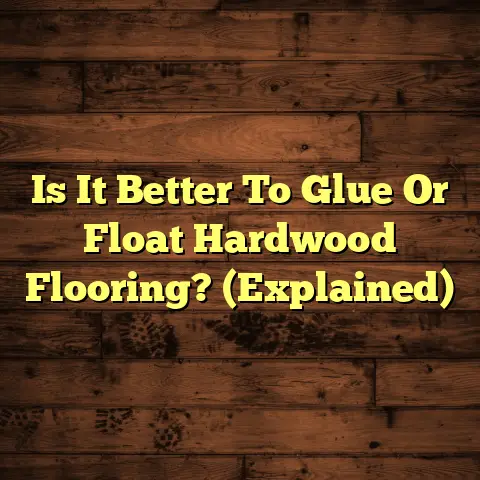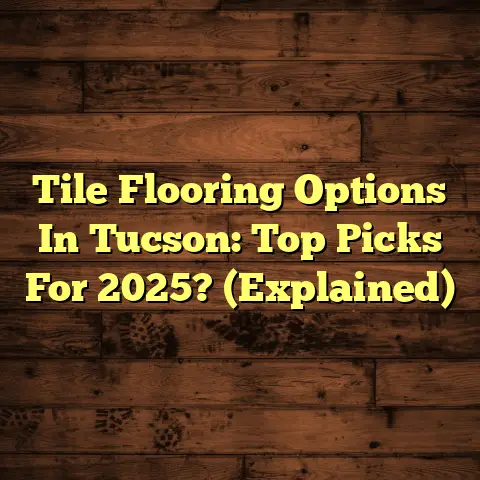Hardwood or Vinyl Plank: Which Wins? (Costly Mistake!)
Choosing the right flooring can feel like navigating a maze, right?
It’s a big decision, and let me tell you, I’ve seen firsthand what happens when folks rush into it without doing their homework. Trust me, a flooring faux pas can be a costly mistake!
Both hardwood and vinyl plank have become super popular for renovations and new builds, and for good reason. They both offer great looks, but they’re also worlds apart in many ways.
In this article, we’re going to break down everything you need to know, from how much each option will set you back to how they stand up to daily wear and tear. I’ll share some insights I’ve picked up over the years, so you can make the best choice for your home, your lifestyle, and your wallet.
So, buckle up, and let’s get started!
1. Budget Options: Show Me the Money!
Understanding the Financial Landscape
Let’s be real: flooring is a big investment. It’s not just about aesthetics; it’s about adding value to your home. But before you get swept away by beautiful visuals, you need to understand the financial landscape.
I’ve seen homeowners get sticker shock when they realize the true cost of their dream floors. It’s not just the material itself; it’s installation, underlayment, and all those hidden expenses that can creep up on you.
Cost Breakdown: Hardwood vs. Vinyl Plank
Alright, let’s get down to brass tacks. Hardwood flooring? It’s the king of the castle, but it comes with a royal price tag.
-
Hardwood Flooring Costs: On average, you’re looking at anywhere from $8 to $25+ per square foot, installed.
- Oak: A classic choice, usually around $8-$15 per square foot installed.
- Maple: A bit more modern, expect to pay $9-$16 per square foot installed.
- Cherry: Luxurious and pricey, often $12-$25+ per square foot installed.
Don’t forget about those extra costs! Underlayment can add another $1-$3 per square foot, and finishing (if you’re going with unfinished wood) can be $2-$5 per square foot.
-
Vinyl Plank Flooring Costs: Now, let’s talk about vinyl plank. It’s the budget-friendly champion, but don’t let the price fool you – some of these options look amazing!
- Standard Vinyl Plank: You can find these starting around $3-$7 per square foot installed.
- Luxury Vinyl Tile (LVT): These higher-end options can range from $5-$12 per square foot installed.
Installation is generally cheaper for vinyl plank, often around $2-$5 per square foot, because it’s easier to work with.
Here’s a quick table to summarize:
| Flooring Type | Material Cost (per sq ft) | Installation Cost (per sq ft) | Total (per sq ft) |
|---|---|---|---|
| Hardwood (Oak) | $7 – $12 | $3 – $6 | $10 – $18 |
| Hardwood (Maple) | $8 – $13 | $3 – $6 | $11 – $19 |
| Hardwood (Cherry) | $10 – $20 | $4 – $7 | $14 – $27 |
| Vinyl Plank (Std) | $2 – $5 | $1 – $3 | $3 – $8 |
| Vinyl Plank (LVT) | $4 – $9 | $2 – $4 | $6 – $13 |
These are average ranges. Actual costs can vary.
Long-Term Financial Considerations
Okay, so you know the upfront costs. But what about down the road?
Hardwood can boost your home’s resale value, no question. A study by the National Association of Realtors found that homes with hardwood floors sell for an average of 2.5% more than homes without. However, it also requires more maintenance. Refinishing can cost $3-$8 per square foot, and you might need to do it every 7-10 years, depending on wear and tear.
Vinyl plank is more durable and requires less maintenance. You probably won’t see the same resale value bump as with hardwood, but you’ll save money on upkeep.
Budget-Friendly Alternatives
Want the look of hardwood without breaking the bank? Consider engineered hardwood. It has a real wood veneer on top of a plywood or fiberboard core, making it more affordable than solid hardwood.
On the vinyl side, keep an eye out for sales and closeouts. You can often find high-quality vinyl plank at discounted prices.
2. Aesthetic Appeal: Beauty is in the Eye…and Under the Feet!
Visual Differences: Natural vs. Man-Made
Let’s face it, aesthetics matter. Your floors are a major part of your home’s overall look and feel.
Hardwood has that undeniable natural beauty. The unique grain patterns, the warmth, the way it ages over time – it’s hard to replicate. Each plank is one-of-a-kind.
Vinyl plank has come a long way in recent years. High-end LVT can mimic the look of wood incredibly well, with realistic textures and patterns. Plus, you have a ton of design options – different wood species, colors, and even tile and stone looks.
Trends and Personalization
What’s hot in the flooring world right now?
- Hardwood: Wide planks are still trending, along with lighter, more natural finishes. Think Scandinavian-inspired looks.
- Vinyl Plank: Waterproof vinyl plank is huge, especially in kitchens and bathrooms. Gray tones and distressed wood looks are also popular.
The great thing about both options is that you can personalize them to fit your style. With hardwood, you can choose your wood species, stain, and finish. With vinyl plank, you can select from a seemingly endless array of styles and colors.
3. Durability and Performance: Standing Up to the Test of Time
Understanding Durability: Kids, Pets, and Life in General
Durability is key, especially if you have kids, pets, or a busy household.
Hardwood is tough, but it can scratch and dent. Softer woods like pine are more susceptible to damage than harder woods like oak or maple. Moisture is also a big enemy of hardwood – spills need to be cleaned up ASAP.
Vinyl plank is a durability superstar. It’s waterproof, scratch-resistant, and stands up to heavy foot traffic like a champ. It’s a great choice for kitchens, bathrooms, and entryways.
Longevity: How Long Will It Last?
With proper care, hardwood can last for decades, even centuries! I’ve seen hardwood floors in historic homes that are still going strong after 100+ years. The key is regular maintenance and refinishing when needed.
Vinyl plank typically lasts 10-20 years, depending on the quality and how well it’s maintained. It’s not going to last as long as hardwood, but it’s also much less demanding.
4. Maintenance and Care: Keeping Your Floors Looking Fab
Cleaning and Upkeep: Elbow Grease Required?
Let’s talk about cleaning.
Hardwood requires a bit more TLC. You need to sweep or vacuum regularly to remove dirt and debris, and use a wood-specific cleaner. Avoid harsh chemicals and excessive water.
Vinyl plank is a breeze to clean. Just sweep or vacuum, and mop with a mild detergent. No special cleaners needed!
Long-Term Maintenance Costs: The Hidden Expenses
Over the long haul, hardwood maintenance can add up. Refinishing, as I mentioned earlier, can be a significant expense. You might also need to repair scratches or dents from time to time.
Vinyl plank is much cheaper to maintain. You might need to replace a plank or two if they get damaged, but that’s usually a simple DIY project.
5. Environmental Impact: Green Choices
Sustainability of Hardwood: Responsible Sourcing
If you’re eco-conscious, you’ll want to consider the environmental impact of your flooring choice.
Hardwood can be a sustainable option if it’s sourced responsibly. Look for wood that’s certified by the Forest Stewardship Council (FSC) or the Sustainable Forestry Initiative (SFI). These certifications ensure that the wood comes from well-managed forests.
Vinyl Plank Considerations: PVC and Recycling
Vinyl plank has some environmental concerns. It’s made from PVC, which is a petroleum-based product. However, some manufacturers are now using recycled PVC in their products. Also, while vinyl plank isn’t widely recycled, some companies are starting to offer recycling programs.
Making Eco-Friendly Choices
When choosing between hardwood and vinyl plank, look for products with low VOC (volatile organic compound) emissions. VOCs can contribute to indoor air pollution.
Conclusion: The Verdict
So, which wins: hardwood or vinyl plank?
Honestly, there’s no one-size-fits-all answer. It depends on your budget, your style, your lifestyle, and your priorities.
If you want the timeless beauty and potential resale value of hardwood, and you’re willing to invest in maintenance, then hardwood might be the way to go.
But if you’re on a budget, need something super durable and easy to care for, and don’t mind sacrificing a bit of that “real wood” feel, then vinyl plank is a fantastic option.
The biggest mistake I see homeowners make is rushing into a decision without considering all these factors. Take your time, do your research, and choose the flooring that’s right for you. Don’t let anyone pressure you into something you’re not comfortable with.
Happy flooring!





